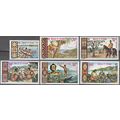Modigliani, Amedeo - The Little Peasant, 1919 - art postcard
- Condition : Used
- Dispatch : 2 Days
- Brand : None
- ID# : 74509832
- Quantity : 1 item
- Views : 268
- Location : United Kingdom

- Seller : justthebook (+1703)
- Barcode : None
- Start : Mon 03 Sep 2012 16:15:39 (BST)
- Close : Run Until Sold
- Remain : Run Until Sold
More Listings from This Seller view all
Seller's Description
- Art Postcard
- Work of art title: The Little Peasant, 1919
- Artist (if known): Amedeo Modigliani
- Media or other details: oil on canvas
- Publisher / Gallery: Tate Gallery, London
- Postally used: no - but with long written message
- Stamp & postmark details (if relevant): na
- Size: modern
- Notes & condition details:
NOTES:
Size: 'Modern' is usually around 6in x 4in / 'Old Standard' is usually around 5 1/2in x 3 1/2in. Larger sizes mentioned, but if you need to know the exact size please ask.
All postcards are not totally new and are pre-owned. It's inevitable that older cards may show signs of ageing and use, particularly sent through the post. Any faults other than normal ageing are noted.
Stock No.: A390
------------------------------------------------
Postage & Packing:
UK (incl. IOM, CI & BFPO): 99p
Europe: GBP 1.60
Rest of world (inc. USA etc): GBP 2.75
No additional charges for more than one postcard. You can buy as many postcards from me as you like and you will just pay the fee above once. (If buying postcards with other things such as books, please contact or wait for invoice before paying).
Payment Methods:
UK - PayPal, Cheque (from UK bank) or postal order
Outside UK: PayPal only please (unless otherwise indicated). NO non-UK currency checks or money orders (sorry).
NOTE: All postcards are sent in brand new stiffened envelopes which I have bought for the task. These are specially made to protect postcards and you may be able to re-use them. In addition there are other costs to sending so the above charge is not just for the stamp!
----------------------------------------------
Text from the free encyclopedia WIKIPEDIA may appear below to give a little background information:
*************
Amedeo Clemente Modigliani (Italian pronunciation: [ame'd?o modi?'?ani]; July 12, 1884 � January 24, 1920) was an Italian painter and sculptor who worked mainly in France. Primarily a figurative artist, he became known for paintings and sculptures in a modern style characterized by mask-like faces and elongation of form. He died in Paris of tubercular meningitis, exacerbated by poverty, overwork and addiction to alcohol and narcotics.
Modigliani was born into a Jewish family in Livorno, Italy. A port city, Livorno had long served as a refuge for those persecuted for their religion, and was home to a large Jewish community. His maternal great-great-grandfather, Solomon Garsin, had immigrated to Livorno in the 18th century as a refugee.[1]
Modigliani's mother (Eug�nie Garsin) who was born and grew up in Marseille, was descended from an intellectual, scholarly family of Sephardic Jews, generations of whom had resided along the Mediterranean coastline. Her ancestors were learned people, fluent in many languages, known authorities on sacred Jewish texts and founders of a school of Talmudic studies. Family legend traced the Garsins' lineage to the 17th-century Dutch philosopher Baruch Spinoza. The family business was believed to be a credit agency with branches in Livorno, Marseille, Tunis, and London. Their financial fortunes ebbed and flowed. At times they enjoyed affluence, at other times they were subject to dire financial crises and reduced circumstances.[2]
Modigliani�s father, Flaminio, hailed from a family of successful businessmen and entrepreneurs. While not as culturally sophisticated as the Garsins, they knew how to invest into and develop thriving business endeavors. Their wealth was derived from mining the metals abundant in the area of Sardinia and Tuscany and extracting and exporting the ores. When the Garsin and Modigliani families announced the engagement of their children, Flaminio was a wealthy young mining engineer. He managed the mine in Sardinia and oversaw the almost 30,000 acres of timberland the family owned. He also was expert in both forestry and farming management.[3] A reversal in fortune occurred to this prosperous family in 1883. An economic downturn in the price of metal plunged the Modiglianis into bankruptcy. Ever resourceful, Modigliani�s mother used her social contacts to establish a school and, along with her two sisters, made the school into a successful enterprise.[4]
Modigliani was the fourth child, whose birth coincided with the disastrous financial collapse of his father's business interests. Amedeo's birth saved the family from ruin; according to an ancient law, creditors could not seize the bed of a pregnant woman or a mother with a newborn child. The bailiffs entered the family's home just as Eugenia went into labour; the family protected their most valuable assets by piling them on top of her.
Modigliani had a close relationship with his mother, who taught him at home until he was 10. Beset with health problems after an attack of pleurisy when he was about 11, a few years later he developed a case of typhoid fever. When he was 16 he was taken ill again and contracted the tuberculosis which would later claim his life. After Modigliani recovered from the second bout of pleurisy, his mother took him on a tour of southern Italy: Naples, Capri, Rome and Amalfi, then north to Florence and Venice.[5][6][7]
His mother was, in many ways, instrumental in his ability to pursue art as a vocation. When he was 11 years of age, she had noted in her diary:
| � | The child's character is still so unformed that I cannot say what I think of it. He behaves like a spoiled child, but he does not lack intelligence. We shall have to wait and see what is inside this chrysalis. Perhaps an artist?[8] | � |
Within a year of arriving in Paris, however, his demeanour and reputation had changed dramatically. He transformed himself from a dapper academician artist into a sort of prince of vagabonds.
The poet and journalist Louis Latourette, upon visiting the artist's previously well-appointed studio after his transformation, discovered the place in upheaval, the Renaissance reproductions discarded from the walls, the plush drapes in disarray. Modigliani was already an alcoholic and a drug addict by this time, and his studio reflected this. Modigliani's behaviour at this time sheds some light upon his developing style as an artist, in that the studio had become almost a sacrificial effigy for all that he resented about the academic art that had marked his life and his training up to that point.
Not only did he remove all the trappings of his bourgeois heritage from his studio, but he also set about destroying practically all of his own early work. He explained this extraordinary course of actions to his astonished neighbours thus:
| � | Childish baubles, done when I was a dirty bourgeois.[15] | � |
The motivation for this violent rejection of his earlier self is the subject of considerable speculation. From the time of his arrival in Paris, Modigliani consciously crafted a charade persona for himself and cultivated his reputation of hopeless drunk and voracious drug user. His escalating intake of drugs and alcohol may have been a means by which Modigliani masked his tuberculosis from his acquaintances, few of whom knew of his condition.[16] Tuberculosis�the leading cause of death in France by 1900[17]�was highly communicable, there was no cure, and those who had it were feared, ostracized, and pitied. Modigliani thrived on camaraderie and would not let himself be isolated as an invalid; he sought to suppress his coughing bouts and any other recognizable signs of the disease that was slowly consuming him. Modigliani used drink and drugs to self-medicate, to serve as palliatives to ease his physical pain, helping him to maintain a facade of vitality and allowing him to continue to create his art.[18]
Modigliani's use of drink and drugs intensified from about 1914 onward. After years of remission and recurrence, this was the period in when the symptoms of his tuberculosis worsened, signaling that the disease had reached an advanced stage.[19]
He sought the company of artists such as Utrillo and Soutine, seeking acceptance and validation for his work from his colleagues.[15] Modigliani's behavior stood out even in these Bohemian surroundings: he carried on frequent affairs, drank heavily, and used absinthe and hashish. While drunk, he would sometimes strip himself naked at social gatherings.[20] He became the epitome of the tragic artist, creating a posthumous legend almost as well known as that of Vincent van Gogh.
During the 1920s, in the wake of Modigliani's career and spurred on by comments by Andr� Salmon crediting hashish and absinthe with the genesis of Modigliani's style, many hopefuls tried to emulate his ""success"" by embarking on a path of substance abuse and bohemian excess. Salmon claimed�erroneously�that whereas Modigliani was a totally pedestrian artist when sober,
| � | ...from the day that he abandoned himself to certain forms of debauchery, an unexpected light came upon him, transforming his art. From that day on, he became one who must be counted among the masters of living art.[21] | � |
While this propaganda served as a rallying cry to those with a romantic longing to be a tragic, doomed artist, these strategies did not produce unique artistic insights or techniques in those who did not already have them
In fact, art historians suggest[21] that it is entirely possible that Modigliani would have achieved even greater artistic heights had he not been immured in, and destroyed by, his own self-indulgences. We can only speculate as to what he might have accomplished had he emerged intact from his self-destructive explorations.
type=printed postcards
theme=artists signed
sub-theme=art
number of items=single
period=1945 - present
postage condition=unposted
Listing Information
| Listing Type | Gallery Listing |
| Listing ID# | 74509832 |
| Start Time | Mon 03 Sep 2012 16:15:39 (BST) |
| Close Time | Run Until Sold |
| Starting Bid | Fixed Price (no bidding) |
| Item Condition | Used |
| Bids | 0 |
| Views | 268 |
| Dispatch Time | 2 Days |
| Quantity | 1 |
| Location | United Kingdom |
| Auto Extend | No |




 for 1 item(s)
for 1 item(s)
















